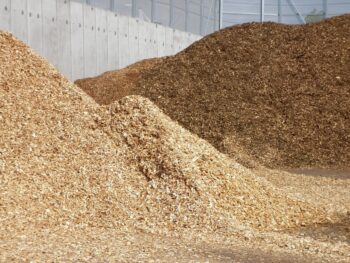Key quality characteristics of woody biomass for bioenergy application: an international review
Globally there is increased demand for sustainable energy solutions as well as an increasing range of bioproducts. This is driving an increased demand for biomass. As these markets grow, mature biomass producers will shift from primarily seeking out economically viable market options to seeking to access the highest value market their biomass resource is suitable for. The ability to match biomass quality and characteristics to market value and opportunities will require a shift from simple trading values based on volume, mass and moisture content to being able to identify and measure characteristics of the biomass that dictate its value in different energy and biomaterial production processes. This basic knowledge of biomass quality will enable effective and economic access to areas with emerging biomass opportunities. Biomass characteristics play an important role in product classification, economic values, and types of usage. Qualitative, physical, and chemical characteristics of biomass feedstocks are important when defining their suitability for different conversion systems, such as direct combustion (heat process), but also thermochemical and biochemical conversion processes to produce liquid biofuels or biochemicals.
This research was initiated by IEA Bioenergy Task 43 (Biomass Supply) with the aim to review and identify the top biomass characteristics as they relate to commercially viable biomaterial and bioenergy processes. The search was restricted to woody biomass and raw feedstock materials. Review results were classified based on regions including Africa, America, Asia, Europe and Oceania. Each case study was described based on the study background, type of biomass and biomass attributes that were measured.
The key biomass characteristics mentioned in biomass studies were moisture content, ash content and calorific value. Other attributes mentioned less frequently were bulk density, contamination, particle shape and nutrient (elemental) content. Detailed information of different case studies is provided in this report.
The paper was published in open access in the Journal Silva Balcanica. Citation:
Ghaffariyan, M.R. 2023. Identifying key quality characteristics of woody biomass for bioenergy application: an international review. Silva Balcanica 24(3): 77-94. https://doi.org/10.3897/silvabalcanica.24.e114644
Download the short summary: Identifying key quality characteristics of woody biomass

Specific conclusions:
Thiffault et al. (2019) concluded that woody residues (especially sawdust) have high level of contaminant and aluminum can have negative impacts on the quality of wood pellets as products. They suggested considering higher quality control practices to ensure the woody residues meet the required specifications of the end users. From wood chip size perspective, research finding showed that increased target chip size can increase the competitiveness of forest biomass through decreased production costs and reduced storage costs. It can also ensure higher and more consistent fuel quality (Anerud et al. 2020).
From application perspective, German scholars such as Kuptz and Hartmann (2014) suggested that wood chip quality is a function of their usage type. For small furnace systems (<1 MW) the quality of wood chips is critical. However, for application in large furnace systems (>1 MW) the quality is less important and secondary issue.
Natural Resources Canada pointed out that reducing moisture content and fine materials in biomass wood chips can help to minimise some risks including microbiological activities, composting and self-ignition. Thus, covering the low moisture wood chips piles is suggested where possible. Increasing chip size during chipping operation can reduce production and storage costs that can result in enhanced competitiveness of forest biomass (Anerud et al. 2020). Coverage of wood chips can generally increase the annual utilisation of trucks and chipper which can reduce operating costs (Anerud et al. 2021).
Biomass characteristics can change over the life of trees. Thus Mann (2012) suggested monitoring the changes of fuel characteristics over the life of the plantation to understand which species are the most suitable for bioenergy production. Different measurement methods yield different level of accuracy. In addition to current laboratory methods to measure biomass characteristics (calorific value, moisture/ash content etc.) Saha et al. (2017) and Fridh (2017) suggested using NIR spectroscopy, X-ray and electric capacitance and magnetic resonance which provide low error of measurement with quicker and easier application.
Future research projects can fill the knowledge gap by studying the biomass quality characteristics from biomass feedstocks and species that have not been yet investigated.
- In Oceania, biomass quality of some commercial species (in different types of biomass feedstocks) could be further investigated. The suggested species include Corymbia maculate, Pinus radiata, Pinus elliottii, Pinus caribaea, Pinus taeda, Araucaria cunninghamii, Eucalyptus globolus, Eucalyptus nitens, Eucalyptus dunnii and Eucalyptus cloeziana.
- In Asia, there is a gap of knowledge on quality characteristics of main species (in various types of biomass feedstocks) such as Chinese fir (Cunninghamia lanceolata) [in China], sugi (Cryptomeria japonica), hinoki (Chamaecyparis obtusa), pines (Pinus spp.) and Japanese larch (Larix leptolepis) [in Japan], Rubber (Hevea brasiliensis), teak (Tectona spp.), pines and Acacia mangium [in Indonesia and Thailand].
- There is also a knowledge gap in Africa to explore variety of biomass types and commercial woody species including pine, eucalyptus and wattle (Acacia spp.).
- European forest biomass quality studies have been mainly published in Sweden and Germany. Future research could be carried out in some Central and Eastern countries to meet with the current demands of bioenergy.
- South America is another region that could benefit from further research projects on forest biomass quality assessment with various commercial species including pines (Pinus spp.), acacia (Acacia spp.) and teak (Tectona spp.) under various biomass feedstocks (wood chips, bundles etc.).
Most of the current knowledge covers the application of woody biomass for bioenergy generation such as heat/power. Future studies around the world could evaluate the quality of biomass for other applications such as biofuels and bioproducts.


